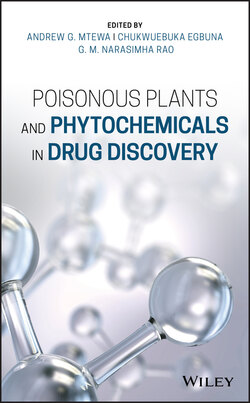Читать книгу Poisonous Plants and Phytochemicals in Drug Discovery - Группа авторов - Страница 22
1.6 Poisonous Plants as Food
ОглавлениеOftentimes, there is no clear line between food plants and toxic and medicinal plants [44]. In many cases, one plant may have particular parts that are poisonous, whereas the other parts are edible or medicinal. A case in point is Abrus precatorius, the seeds of which are highly toxic; however, the leaves are edible and are used in traditional medicine [45]. The seeds of Malus spp. (apple) are also poisonous and contain the toxin amygdalin, which is a cyanogenic glycoside [5]. In some cases, the toxic parts have to be detoxified first through various elaborate and careful processes to render them edible. Although several plant species that are potentially toxic are consumed as food and also used as medicine, this section will focus on a few examples of plant species that are widely used as food and are also known to be toxic.
One of the most prominent examples of such toxic and edible plants is the cycad. Cycads have been widely researched as poisonous food plants. Cycads are indigenous to the tropics and subtropics, where they have been used both as a staple and as emergency food and medicine for various ailments [46, 47]. Natives of particular areas have long been aware of their toxicity, which especially manifests as gastrointestinal and neurological effects. In cattle, for instance, continued ingestion leads to irreversible paralysis of the extremities [44].
The nutritional value of cycads principally lies in an edible starch extracted from the roots, stems, and nuts [44]. Cycads produce flour with a high nutritional value [48]. Several precautions are taken when preparing it as a food. A high‐quality food starch is extracted from the fibrous pulp of cycads through alternate processes of cutting, drying, and soaking [44]. In some parts of Uganda, for example, the hard seed of the cycad Encephalartos hildebrandtii can be boiled and ground into flour in times of famine. The starchy center of the stem is also edible [49].
There have been repeated accounts of poisoning from cycad ingestion during periods of famine. This has been attributed to inadequate preparation of cycad products, possibly because of a lack of knowledge of the toxicity of the plants or because of their unpredictable variations in toxicity [44].
Compounds from cycads are carcinogenic in various laboratory animals [50]. Hirono et al. [51] showed a high death rate from liver cirrhosis in the Miyako Islands of Japan that may be correlated to the consumption of cycads during periods of crop loss. Cycad flour contains the neurotoxin beta‐methylamino‐L‐alanine (BMAA) [52] as well as other neurotoxins, as reviewed by Rivadeneyra‐Domínguez and Rodríguez‐Landa [48].
Duncan et al. [52] showed that 87% of the total BMAA content of Cycas circinalis seeds collected on Guam island was removed during traditional processing. They concluded that processed cycad flour as prepared on Guam contains extremely low levels of BMAA (0.005% by weight), making it unlikely to cause the delayed and widespread neurofibrillary degeneration of nerve cells observed in amyotrophic lateral sclerosis and the parkinsonism–dementia complex of Guam [52].
Another widely used toxic plant species is cassava (Manihot spp.), which is consumed after detoxification. Cassava contains potentially toxic levels of cyanogenic glucosides, made up of linamarin (95% of total cyanogen content) and lotaustralin (5%) [53]. Sun‐drying and crushing cassava roots to make flour removes 96–99% of total cyanogens [54]. Cyanide intake from a cassava‐dominated diet has been put forward as a contributing factor in two forms of nutritional neuropathies in Africa: tropical ataxic neuropathy and epidemic spastic paraparesis. Therefore, proper processing of the cassava root is required to detoxify it for safe consumption [5, 55]. It is thus important to beware of the potential toxicity of various plant species while trying to meet the food security needs of vulnerable populations [48].
